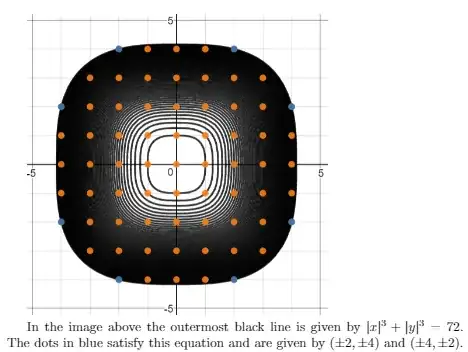A note about this question: The original question asked seems likely impossible so I am really asking if we can exploit the technique below into giving us a 'nice' form for $\pi^4$. By nice form I mean an explicitly defined series of rationals.
A little explanation of the the technique.
The technique I use below I reference quite a bit on this site and therefore am putting a nice explanatory picture. The technique is a type of "Diophantine Approximation" I suppose. I don't know if the technique goes by a special name.
We are going to count the number integer solutions along some Diophantine equation $P(x,y)=n$. If let $\phi_n$ denote the number of solutions in $\mathbb{Z}$ to $P(x,y)=n$ then we may argue (under some conditions) that $\sum_{n=1}^N \phi_n$ approximates the area of the interior of $P(x,y)=N$. Let me give a concrete example. Let $P(x,y)=|x|^3+|y|^3$.
The actual area in the interior of $|x|^3+|y|^3=72$ is given by $\frac{72\Gamma(1/3)^3}{4\sqrt{3}\pi} \approx 63.59899501$ and this is weakly approximated by $69$ which is the total number of integers which are on some solution of $|x|^3+|y|^3=n$ as $n$ varies from $0$ to $72$. Approximating this area as the number of integer solutions should improve as a we let $n$ grow large.
Specific Question
Let $R$ be a whole number. Is it possible for any whole number $c>0$ that there is a nicer form for $\sum_{r=1}^{R^c}\sum_{d|r}(-1)^{r+d} d^3$? I can hope that we can just evaluate this sum but in lieu of that maybe something cheaper computationally. Taking $c=1$ we can examine: $$f(x)=\sum_{r=1}^{x}\sum_{d|r}(-1)^{r+d} d^3$$ Here is a table of the first 100 values of this function $f$. This function must grow $O(x^4)$ for reasons which should be clear after reading the exposition. TLDR: $f(x)/x^4$ limits to $\frac{\pi^4}{384}$ as $x$ gets large.
Edit 1: After thinking about this specific question I realized it's somewhat an unreasonable ask... In someways this specific question is tantamount to asking the Gauss circle problem but in 8 dimensions and not 2. It's seems that this problem doesn't have an answer for $2$-d case and it's not likely any easier as we increase the dimension. What I am really after is if we can exploit this summation to arrive at an expression for $\pi^4$ which isn't a divisor sum the same way we can do this in the 2 dimensional case. Full apologies: This is really a different question than the original query but considering the original query is likely impossible...
Exposition.
Let $\phi_n(r)$ denote the number of integer solutions to the $n$-dimensional hypersphere $r=\sum_{i=1}^n x_i^2$.
The 2-dimensional case.
Then discovering $\phi_2(r)=4 \sum_{d|r} \sin(\frac{\pi}{2}d)$ allows us to find a formula for $\pi$. Namely, Leibniz's formula for $\pi$. Considering that the sum of number of integer solutions for each $r$ from $1$ to $R^2$ should approximate the volume of a sphere (which for this special case $n=2$ goes by the special name 'circle') with radius $R$ we arrive at:
$$\pi R^2 \approx\sum_{r=1}^{R^2}\phi_2(r)$$ and after dividing both sides by $4R^2$ and unpacking our definitions we arrive $$\frac{\pi}{4}=\lim_{R\to\infty} \frac{1}{R^2}\sum_{r=1}^{R^2}\sum_{d|r}\sin \Big(\frac{\pi}{2}d \Big)=\sum_{n=1}^\infty{\frac{1}{n}\sin\Big(\frac{\pi}{2}n \Big)}=1-\frac{1}{3}+\frac{1}{5}-\frac{1}{7}+ \dots $$
The second equality is sometimes referred to as a dirichlet convolution (I think). And it's this step that I can't seem to be able to take in $8$-dimensional case.
I will skip the 4-dimensional case.
But indeed, examining the 4 dimensional case we can achieve $\zeta(2)=\pi^2/6$. This can be found in the last proof in R. Chapman's compilation of proofs of the Basel problem. MSE has it's own compilation of these by the way.
So now that we've seen the development for a $2$ and $4$ dimensional sphere:
What's the development for 8-dimensional sphere?
Note that the ${\phi_8(r)= 16\sum_{d|r} (-1)^{r+d}d^3}$ which gives a way of approximate the volume of an $8$-dimensional hypersphere:
$$\frac{1}{24}\pi^4 R^8 \approx \sum_{r=1}^{R^2}\phi_8(r)$$
We divide both sides by $16R^8$ to arrive at
$$\frac{\pi^4}{384}= \lim_{R\to\infty} \frac{1}{R^8}\sum_{r=1}^{R^2} \sum_{d|r} (-1)^{r+d}d^3$$
In fact! It looks to me like for any whole number $c$,
$$\frac{\pi^4}{384}= \lim_{R\to\infty} \frac{1}{R^{4c}}\sum_{r=1}^{R^c} \sum_{d|r} (-1)^{r+d}d^3$$
This does provide a nice sequence which converges to $\pi^4/384$. Letting $c=1$ this sequence's rate of convergence is pretty atrocious.
$$1,\frac{8}{16},\frac{36}{81},\frac{107}{256},\frac{233}{625},\dots $$
The printed numbers are all accurate to ... zero decimal places... it should converge nonetheless.
but taking $c$ larger we arrive at this number much faster. For $c=2$,
$$1,\frac{107}{256},\frac{2113}{6561},\frac{19128}{65536}, \dots $$
Only the last number printed is accurate to the first decimal of $\pi^4/384$.
Can I see anything else here? Is there a closed form for this
$$\sum_{r=1}^{R^c}\sum_{d|r}(-1)^{r+d} d^3$$
Sequences of interest include A008457, A138503. I think this link may be a good resource but (I am pretty sure) the "formula" therein should be labelled as a generating function A055414.
I suppose it's unlikely that the problem is easier $c>1$ but I figured I would include this thought just in case the problem is somehow solvable for some specific $c$.
A more general food for thought question Does this development get me similar looking things for other dimensions $n$?
